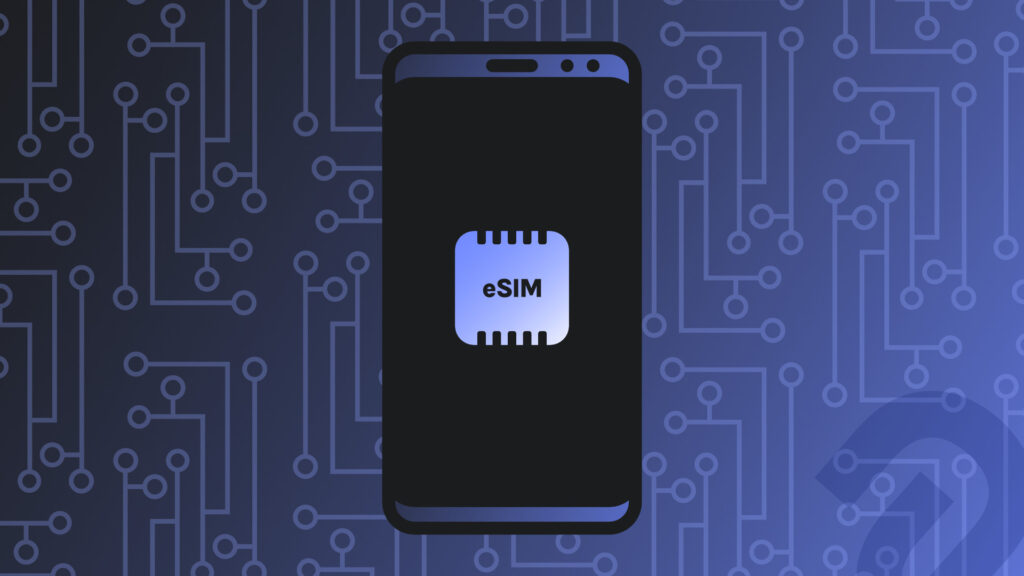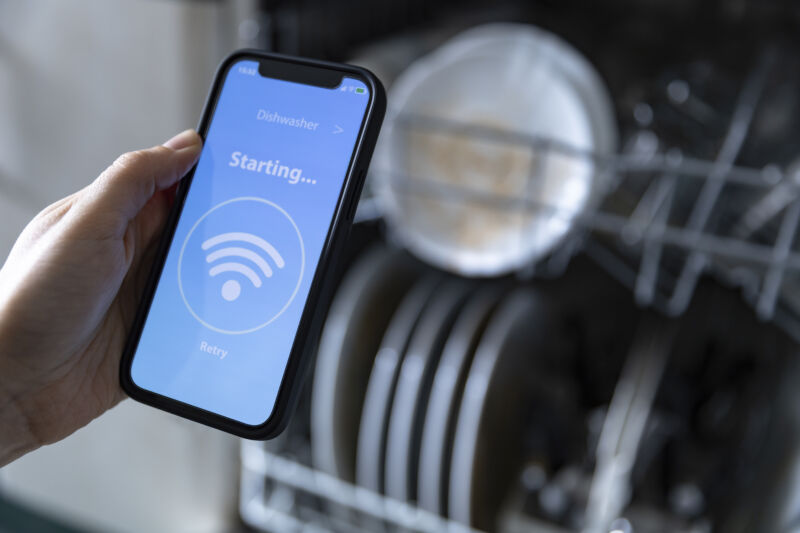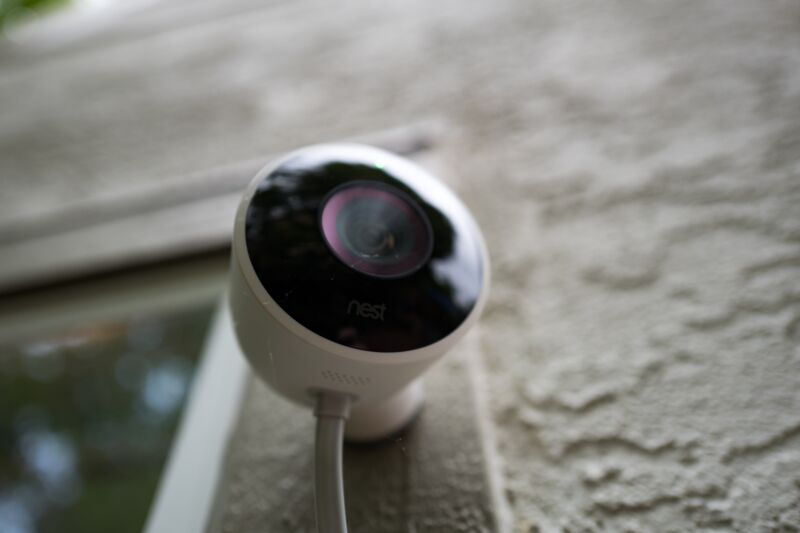-
chevron_right
Que signifie eSIM ?
news.movim.eu / Numerama · Sunday, 5 February, 2023 - 13:05

Abonnez-vous aux newsletters Numerama pour recevoir l’essentiel de l’actualité https://www.numerama.com/newsletter/
Que signifie eSIM ?
news.movim.eu / Numerama · Sunday, 5 February, 2023 - 13:05

Abonnez-vous aux newsletters Numerama pour recevoir l’essentiel de l’actualité https://www.numerama.com/newsletter/
 chevron_right
chevron_right
Appliance makers sad that 50% of customers won’t connect smart appliances
news.movim.eu / ArsTechnica · Tuesday, 24 January, 2023 - 18:20 · 1 minute

Enlarge / This hypothetical dishwasher owner is one of a minority of smart appliance customers getting the full value of their device, including timely reminders to buy more of the company's recommended dishwasher tabs and cleaning packs. (credit: Dani Serrano/Getty Images)
Appliance makers like Whirlpool and LG just can't understand. They added Wi-Fi antennae to their latest dishwashers, ovens, and refrigerators and built apps for them—and yet only 50 percent or fewer of their owners have connected them. What gives?
The issue, according to manufacturers quoted in a Wall Street Journal report (subscription usually required), is that customers just don't know all the things a manufacturer can do if users connect the device that spins their clothes or keeps their food cold—things like "providing manufacturers with data and insights about how customers are using their products" and allowing companies to "send over-the-air updates" and "sell relevant replacement parts or subscription services."
“The challenge is that a consumer doesn’t see the true value that manufacturers see in terms of how that data can help them in the long run. So they don’t really care for spending time to just connect it,” Henry Kim, US director of LG's smart device division ThinQ, told the Journal.
 chevron_right
chevron_right
#IOT In Healthcare Market: Competitive Analysis and Global Outlook 2022-2026
Sagar · Monday, 26 December, 2022 - 11:14 · 2 minutes
Stratview Research has published a new report titled “IoT in Healthcare Market” which is segmented By Component (System and Software, Device, Service), Application (Patient Monitoring, Clinical Operation and Workflow Optimization, Clinical Imaging, Fitness and Wellness Measurement, Drug Development), End user (Healthcare Providers, Patients, Healthcare Payers, Research Laboratories (Biotech/Pharma), Government Authority), and by Region Asia-Pacific [China, Japan, India, and Rest of Asia-Pacific], and Rest of the World [Brazil, Saudi Arabia, and Others]).
Get free sample repost here: https://www.stratviewresearch.com/Request-Sample/2696/iot-in-healthcare-market.html#form
Report Highlights
This report covers comprehensive data on emerging trends, market drivers, growth opportunities, and restraints that can affect the market dynamics of the industry. It provides thorough analysis of the market segments which include products, applications, and competitor analysis.
The market is bifurcated into various segments. Below given is the segment-wise analysis -
By product, the IoT in Healthcare market has been bifurcated into disposable IoT in Patient Monitoring, Clinical Operation and Workflow Optimization, Clinical Imaging, Fitness and Wellness Measurement, Drug Development.
The Patient Monitoring segment accounted for the largest market share in 2020. It offers a variety of monitoring systems designed to collect physiological data, which is then analysed and stored via gateways and clouds.
Which Region is expected to remain the largest market?
By region, the IoT in Healthcare market is expected to be dominated by Asia Pacific. The APAC region is experiencing rapid growth in the IoT in healthcare market.
Because the APAC region contains more than half of the world's population, any major technological shifts, such as those heralded by IoT, are likely to shape the region's future. Many Asian countries, including China, Japan, and India, are leveraging information-intensive Internet of Things (IoT) technologies to meet rising healthcare service demand, and as a result, APAC is expected to offer promising opportunities to deploy IoT in healthcare solutions.
Who are the Key Players in the Market? This report provides market intelligence in the most comprehensive way. It also provides critical insights into the key players active in the market, that will enable strategic decision-making for the existing market players as well as those willing to enter the market. The following are the key players activen in the IoT in Healthcare Market: • Agamatrix (US) • Armis (US) • Bosch (Germany) • Capsule Technologies (US) • Comarch SA (Poland) • Cisco Systems (US) • GE Healthcare (US) • HQSoftware (Estonia)
Custom Research:
Stratview research delivers custom research services across the sectors. In case of any custom research requirements, please send your inquiry to sales@stratviewresearch.com. Or connect with our experts at +1-313-307-4176.
About Us
Stratview Research is a global market research firm, offering syndicated and custom research reports along with growth consulting services. Our business intelligence and industry research reports offer clients with insightful market data to aid strategic decision making. These exclusive reports are the result of exclusive research methodology and are available for key industries such as chemicals, composites, advanced materials, technology, renewable energy, and more.
 chevron_right
chevron_right
Everything we know about the White House’s IoT security labeling effort
news.movim.eu / ArsTechnica · Thursday, 20 October, 2022 - 22:59 · 1 minute

Enlarge / Home security cameras are some of the first devices to be considered for a security “nutrition label” that could launch in spring 2023. (credit: Getty Images)
The White House issued a statement today that said, essentially, it hosted a big meeting on Wednesday, with big names, and that some kind of security label for smart devices will come of it in spring 2023. Here’s a good deal more on what happened, and what’s likely to come out of it.
One of the top-level recommendations of the US Cyberspace Solarium Commission, named for the Eisenhower administration’s drive to rethink Cold War strategy , in its March 2020 report was to, “Establish a national cybersecurity certification and labeling authority.” A “non-profit, non-governmental organization” will become a labeling authority for at least five years, tagging products based on the consensus of the departments of Commerce and Homeland Security, and “experts from the federal government, academia, non-governmental organizations, and the private sector.”
And that’s about who showed up, according to the White House. Amazon, Comcast, Google, Intel, LG, Samsung, Sony, and other private entities showed up. So did the Connectivity Standards Alliance, the consortium behind Matter , along with the American National Standards Institute (ANSI), Consumer Reports, and the Consumer Technology Association, CTIA, and National Retail Federation lobbying groups. Add in just about every security-touching government agency, and you’ve got the panel the Solarium Commission recommended.
 chevron_right
chevron_right
IoT harmony? What Matter and Thread really mean for your smart home
news.movim.eu / ArsTechnica · Thursday, 6 October, 2022 - 14:37 · 1 minute

Enlarge / Matter promises to make smart home devices work with any control system you want to use, securely. This marketing image also seems to promise an intriguing future involving smart mid-century modern chairs and smart statement globes. (credit: CSA)
The specification for Matter 1.0 was released on Tuesday—all 899 pages of it . More importantly, smart home manufacturers and software makers can now apply for this cross-compatibility standard, have their products certified for it, and release them. What does that mean for you, the person who actually buys and deals with this stuff?
At the moment, not much. If you have smart home devices set up, some of them might start working with Matter soon, either through firmware upgrades to devices or hubs. If you're deciding whether to buy something now, you might want to wait to see if it's slated to work with Matter. The first devices with a Matter logo on the box could appear in as little as a month. Amazon, Google, Apple, and Samsung's SmartThings division have all said they're ready to update their core products with Matter compatibility when they can.
That's how Matter will arrive, but what does Matter do? You have questions, and we've got... well, not definitive answers, but information and scenarios. This is a gigantic standards working group trying to keep things moving across both the world's largest multinational companies and esoteric manufacturers of tiny circuit boards. It's a whole thing. But we'll try to answer some self-directed questions to provide some clarity.
 chevron_right
chevron_right
Xiaomi veut améliorer la vie de votre animal de compagnie avec ces deux produits connectés
news.movim.eu / JournalDuGeek · Tuesday, 4 October, 2022 - 15:45


La maison connectée de Xiaomi s'agrandit avec deux nouveaux appareils pour nourrir et hydrater nos compagnons à quatre pattes : le Xiaomi Smart Pet Feeder, son distributeur automatique de croquettes et la Xiaomi Smart Pet Fountain, sa fontaine à eau, le tout connecté !
Xiaomi veut améliorer la vie de votre animal de compagnie avec ces deux produits connectés
 chevron_right
chevron_right
SmartDry’s useful laundry sensor to be cloud-bricked next month
news.movim.eu / ArsTechnica · Tuesday, 30 August, 2022 - 17:14

Enlarge / The SmartDry laundry sensor was widely regarded as a useful smart home gadget that saved money and time. When its owners' servers go dark at the end of September, users face a useless device or a notable DIY journey. (credit: Getty Images)
SmartDry was a smart home product that did something useful: tell you when your clothes in your dryer were actually dry.
A small pack mounted inside nearly any dryer drum could prevent clothes from shrinking, save you energy costs (at least $60 per year, the marketing claimed), and even warn you about clogged vents causing high heat—or, much worse, gas buildup. A second-generation version could even turn off your gas dryer automatically. Reviewers greatly preferred it to their own dryers' unpredictable dryness sensors.
The problem is that SmartDry alerted you to dry clothing by connecting to your home's Wi-Fi; the device sent a message to parent company Connected Life's servers and then relayed that message to your smartphone. But Connected Life Labs is closing, discontinuing SmartDry, and shutting down its servers on September 30. After that, "cloud services will cease operations and the product apps will no longer be supported."
 chevron_right
chevron_right
Gear from Netgear, Linksys, and 200 others has unpatched DNS poisoning flaw
news.movim.eu / ArsTechnica · Tuesday, 3 May, 2022 - 21:15

Enlarge (credit: Getty Images)
Hardware and software makers are scrambling to determine if their wares suffer from a critical vulnerability recently discovered in third-party code libraries used by hundreds of vendors, including Netgear, Linksys, Axis, and the Gentoo embedded Linux distribution.
The flaw makes it possible for hackers with access to the connection between an affected device and the Internet to poison DNS requests used to translate domains to IP addresses, researchers from security firm Nozomi Networks said Monday . By feeding a vulnerable device fraudulent IP addresses repeatedly, the hackers can force end users to connect to malicious servers that pose as Google or another trusted site.
The vulnerability, which was disclosed to vendors in January and went public on Monday, resides in uClibc and uClibc fork uClibc-ng , both of which provide alternatives to the standard C library for embedded Linux. Nozomi said 200 vendors incorporate at least one of the libraries into wares that, according to the uClibc-ng maintainer , include the following:
Spamhaus: When doorbells go rogue!
pubsub.slavino.sk / spam_resource · Thursday, 21 October, 2021 - 12:00
From Spamhaus: Here's a bonkers tale about a spamming doorbell . Oof, crappy "internet of things" devices are a scourge unto the internet. Alex Grosjean shares this very interesting story of tracking down where the spam was coming from on a home broadband subscriber's network. And why ISPs ought to be blocking port 25. And why IOT devices need to be more secure.
[ H/T: Kiersti Esparza and Atro Tossavainen ]